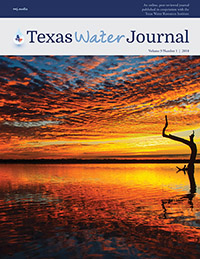Abstract
The Ogallala Aquifer extends beneath eight states in the Great Plains region of North America. It stretches from Texas to South Dakota and is among the largest aquifers in the world. In Texas, extraction of groundwater, primarily for cropland irrigation, far exceeds recharge resulting in a significant decline of the water table. In the Texas High Plains, this decline prompted restrictions set by a local water conservation agency in 2009 stating that in 50 years about 50% of the saturated thickness of the Ogallala Aquifer should be preserved. However, this restriction only addressed the quantity and not the quality of the remaining water. The quality of water extracted from the Ogallala Aquifer has been observed to change over time, especially over the length of a crop’s growing season. We measured water quality over a three-year period using an electrical conductivity sensor and measured depth to water at 20 locations across five counties in the Texas High Plains. Results show that when wells are actively pumping, water quality can change in complex and unpredictable ways. In some cases, water quality declined and in others water quality improved. This result has prompted us to further investigate the mechanisms involved in observed seasonal water quality changes.
References
Bordovsky JP, Porter D, Johnson J. 2012. Effects of variable in-season irrigation capacity on cotton. Annual Report. Texas A&M AgriLife Research Project. 33 p. Project 11-811.
Chaudhuri S, Ale S. 2014. Long term (1960–2010) trends in groundwater contamination and salinization in the Ogallala aquifer in Texas. Journal of Hydrology. 513:376- 390. Available from: https://doi.org/10.1016/j.jhy¬drol.2014.03.033.
Cronin JG. 1969. Ground water in the Ogallala Formation in the southern High Plains of Texas and New Mexico. Washington (District of Columbia): U.S. Department of the Interior Geological Survey. Hydrologic Atlas 330.
Custodio E. 2002. Aquifer overexploitation: what does it mean? Hydrogeology Journal. 10(2):254–277. Available from: https://doi.org/10.1007/s10040-002-0188-6.
Darton NH. 1898. Underground waters of a portion of south¬eastern Nebraska. Govt. Print. Off.
Druhan JL, Hogan JF, Eastoe CJ, Hibbs BJ, Hutchinson WR. 2008. Hydrogeologic controls on groundwater recharge and salinization: a geochemical analysis of the northern Hueco Bolson aquifer, Texas, USA. Hydrogeology Journal. 16 (2):281-296. Available from: https://doi.org/10.1007/s10040-007-0222-9.
Dutton AR, Reedy RC, Mace RE. 2001. Saturated thickness in the Ogallala aquifer in the Panhandle Water Planning Area: simulation of 2000 through 2050 withdrawal pro¬jections. Final Contract Report. Austin (Texas): Bureau of Economic Geology, University of Texas at Austin.
Gollehon N, Winston B. 2013. Groundwater irrigation and water withdrawals: the Ogallala Aquifer initiative. US Department of Agriculture-Natural Resources Conserva¬tion Service. Economic Series Number 1.
Hanor JS. 1994. Origin of saline fluids in sedimentary basins. Geological Society, London, Special Publications. 78 (1):151-174. Available from: doi: 10.1144/GSL.SP.1994.078.01.13.
[HPWD] High Plains Water District. 2014. HPWD manage¬ment plan 2014–2024. High Plains Underground Water Conservation District No. 1. 49 p.
Holliday VT. 1995. Stratigraphy and paleoenvironments of late Quaternary valley fills on the Southern High Plains. Geological Society of America Memoirs. 186:1-131. Avail¬able from: https://doi.org/10.1130/0-8137-1186-X.1
Howell TA, Evett SR, Tolk JA, Schneider AD, Steiner JL. 1996. Evapotranspiration of corn - Southern High Plains. In: Camp CR, Sadler EJ, editors. Evapotranspiration and Irrigation Scheduling. Proceedings of the International Conference; San Antonio (Texas): American Society of Agricultural Engineers. p. 158-166.
Kreitler CW. 1993. Geochemical techniques for identifying sources of ground-water salinization: CRC Press. 272 p.
Lascano RJ. 2000. A general system to measure and to calcu¬late daily crop water use. Agronomy Journal. 92:821-832. Available from: doi:10.2134/agronj2000.925821x.
Ledbetter K. 2014. Salinity of growing concern for Ogallala Aquifer. Southwest Farm Press. 41(10):16-18.
McCain C. 1996. Average decline of 1.91 feet recorded in Dis¬trict observation wells in 1995. The Cross Section. 42(4):1.
McGuire VL. 2014. Water-level changes and change in water in storage in the High Plains aquifer, predevelopment to 2013 and 2011–13. U.S. Geological Survey Scientific Investigations Report 2014-5218. 14 p. Available from: https://doi.org/10.3133/sir20145218.
Mullican WF 3rd. 2013. The rate of groundwater level decline. The Cross Section. 59(5):1.
Robbins HW. 1941. The Pleistocene geology of Portales val¬ley, Roosevelt County, New Mexico, and certain adjacent areas. University of Nebraska (Lincoln Campus). 92 p.
[TAWC] Texas Alliance for Water Conservation. 2013. An integrated approach to water conservation for agriculture in the Texas Southern High Plains. Texas Alliance for Water Conservation (TAWC) Project Summary 2005–2012. 30 p.
Whitehead BP. 2007. Investigating depletion of the Southern High Plains (Ogallala) Aquifer [thesis]. [Mankato (Minne¬sota)]: Minnesota State University.
Williams WD. 2001. Anthropogenic salinisation of inland waters. Hydrobiologia. 466(1-3):329-337. Available from: https://doi.org/10.1023/A:1014598509028.

This work is licensed under a Creative Commons Attribution 4.0 International License.
Copyright (c) 2018 Timothy S. Goebel, John E. Stout, Robert J. Lascano





